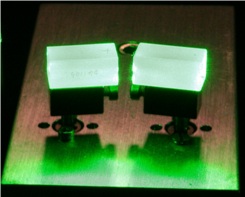In order to carry out our photofragmentation experiments, we utilize OPO/OPA (LaserVision) lasers that produce the required tunable infrared radiation over the 600-4500 cm-1 range. These systems exploit the nonlinear optical properties of potassium titanyl phosphate (KTP),  potassium titanyl arsenate (KTA), and AgGaSe2crystals to generate this tunable infrared radiation. Each IR-system is pumped by the 1064 nm fundamental of a high-power Nd:YAG laser. The process of producing tunable IR begins with splitting the 1064 nm fundamental into two beams. The first beam is frequency doubled (ω532) in a KDP crystal and is then oscillated in two KTP crystal optical parametric oscillator (OPO), generating two new (tunable!) beams: a near‑IR 1400-2000 nm (ω1500) and an 855-720 nm (ωred) beam. By conservation of energy, the sum of these two photons is equal to that of the pumping 532 nm photon (ω532 = ω1500 + ωred). Due to the crystals’ birefringent nature, changing the crystal angle requires new “phase matching” conditions to be met in order to conserve photon momentum and allows for the generation of tunable radiation.
potassium titanyl arsenate (KTA), and AgGaSe2crystals to generate this tunable infrared radiation. Each IR-system is pumped by the 1064 nm fundamental of a high-power Nd:YAG laser. The process of producing tunable IR begins with splitting the 1064 nm fundamental into two beams. The first beam is frequency doubled (ω532) in a KDP crystal and is then oscillated in two KTP crystal optical parametric oscillator (OPO), generating two new (tunable!) beams: a near‑IR 1400-2000 nm (ω1500) and an 855-720 nm (ωred) beam. By conservation of energy, the sum of these two photons is equal to that of the pumping 532 nm photon (ω532 = ω1500 + ωred). Due to the crystals’ birefringent nature, changing the crystal angle requires new “phase matching” conditions to be met in order to conserve photon momentum and allows for the generation of tunable radiation.
The 1400-2000 nm beam is then aligned through a four KTA crystal optical parametric amplifier (OPA). The second 1064 nm beam pumps this OPA chain, amplifying the 1500 nm beam and generating a new one in the 4300-2200 nm range (ω3000). Again, conservation of energy (ω1064 = ω1500 + ω3000) is required and tunability is achieved by altering the angles of the crystals. The new 3000 nm beam is tunable over the 2350-4500 cm-1 range that is used in our photofragmentation experiments. The lower energy IR is generated by difference frequency generation combining the ω1500 and ω3000 beams through an AgGaSe2 crystal, which results in radiation spanning 600 – 2500 cm-1.

We currently deploy three of these tunable infrared lasers, including an in-house developed high-power system which includes a second Nd:YAG pump and second 1500 nm amplification stage.
(1) W. Koechner, “Solid-State Laser Engineering,” Springer Science, New York, NY, 2006.